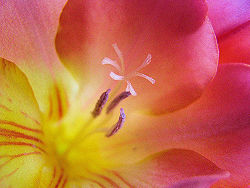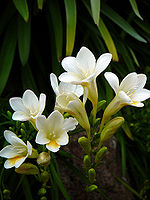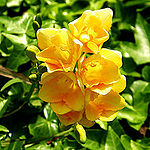Freesia
| Freesia |
|---|

|
| Scientific Classification |
|
| Species |
|
Freesia are ornamental flowering plants that originated from South America and have quickly been adopted by many countries because of its unique qualities. Despite being gorgeous and having vivid flower colors, freesias also have a very unique scent. Some have described the scent as a mixture of spicy and floral. Because of its unusual scent, Freesias were quickly adopted into the line of beautification where it is utilized in soaps, perfumes, and massage lotions. [1]
Anatomy
Freesias are not only charming by way of their unusual scent, but also in their diverse vivid pigments. Colors in freesias consist of pink, red, orange, yellow, blue, lavender, cream, and white. Some flowers are multicolored and possess several variations of color within the same bud. [2] Being herbaceous, they grow from corms, which vary from 1-2.5 cm in diameter, and then sprout into a clump of leaves. The leaves are narrow, with average lengths ranging from 10-30 cm long. The leaves are green and possess neither hairs nor extra-floral nectaries. Freesias also bear a single sparsely branched stem 10-40 cm tall. At the top of the stem, there is a one-sided spike hosting 5-12 flower buds. [3] Freesias are zygomorphic, meaning that they grow along only the bottom side of the stem. The blossoms however are facing upwards because the stems take a sharp upward turn, just below the bud. [4] The total plant height may range from 12” to 18”, depending on the species. [5]
Reproduction
Freesias reproduce by way of seeds, corms, and bulbils. [6] The most common way to begin growing Freesias is by planting Freesia corms. The corms will fare best if planted close, six in a 5 in pot is reasonable. One should use light soil and proper drainage when dealing with Freesias. When planted, the top of the corm should be 1in below the top of the soil. [7] Freesias are perennials, meaning that they bloom for only a short amount of time each year but will return year after year. [8] The best and most common planting time for Freesias is in the late summer to early fall. This is done because they are winter flowers and must be kept cool until the frosts come. During this time, it is best to bring the Freesias in and house them in a sunny window. [9] This way the plants will be healthy for seeding in the spring. Freesias produce several hundred seeds per plant, ranging from 50-1000 propagules per plant. Seeds and bulbs are relocated by elements, such as water and wind, to their new housing locations. Although, to produce the seed the plant must first experience pollination. The pollen located on the flowers stamen is transported via external transportation, such as wind, bees, and other insects, to the stigma of another flower. This fertilizes the egg which is then encompassed in a non-fleshy fruit for protection. [10]
Ecology
Freesias are African in origin. Some are native to Cape Province, South Africa, tropical Africa, and even into Sudan. [11] Freesias can be grown outdoors in warm climates, but in colder climates it is wise to grow the plants indoors. Freesias, as bulbs, are stored at a maximum temperature of 40° F with exposure to full sunlight. [12] They are then grown at temperatures of 50° to 70° F. [13] Though planted in the late summer to early fall, the Freesias wait until spring to seed. This means that, during the cold months in the winter, the plants have to find a way to protect themselves from the bitter cold. The freesias have a tactic of dying off to their underground food storage source and staking out until the cold season has passed. This technique is also utilized for protection from drought, fire, and flooding. [14]
Freesia Oils
Freesias are known for their unique mixture of spicy and floral scents. Because of their delectable fragrance, Freesias have been drafted as a vital ingredient in many fragrance oils. Freesia fragrance oils are utilized for many oil burners and vaporizers. It is used as an essential fragrance in potpourris. It can also be used in any vaporizer, in a drive time car vaporizer, radiator vaporizer, or mini vaporizer. Freesia essence oil is high grade essence oil. This is because it is undiluted, alcohol free, and long lasting. The oil is used for aromatherapy to scent candles, soaps, massage oils, bath oils, and perfumes. [15]
Gallery
References
- Freesia March 13, 2009
- Freeisa Anatomy October 30, 2008
- Growing Freeisa Douglas Green, 2008
- Freesia Growing Information 2009
- Growing:Freesia Ellen Brown
- Invasiveness Assessment - Freesia September 24, 2009
- Freesia - Garden Basics - Flower - Bulb Hillclimb Media
- Freesia Flowers November 1, 2008









